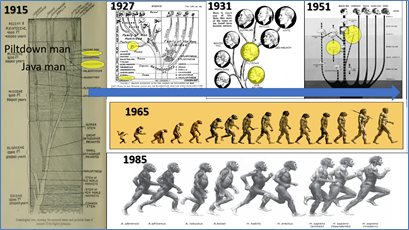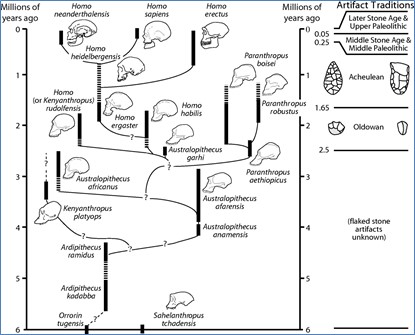No products in the cart.
Return To ShopHuman Family Tree and “March of Progress” Icon
Natural history museums and school textbooks display human evolution “trees” or “march of progress” infographics that supposedly show humans evolving from ape-like creatures over millions of years.

When looking at these graphics over the last 100 years, it becomes really obvious how inconsistent these line-ups have been over the generations. Consider Piltdown Man, or Eoanthropus dawsoni which was based on a skull found in 1912. This was thought of as the official “missing link” between ape and man[i] and portrayed in classrooms, textbooks, and museums as one of the leading proofs of human evolution. It was even on the front cover of leading evolution textbooks for decades. However, it was exposed in 1953 as a forgery, after carrying the role of “missing link” for 41 years.
Java Man, or Pithecanthropus erectus, also played its role in the lineup, even though it was based on just a single tooth and a skullcap and thighbone found about a year apart and 50 feet from each other in east Java. Numerous museum exhibits and statues were made of this creature around the world.

Java Man toppled in the 1930s and 40s when other experts studied the bones and re-classified them as Homo erectus, a label given to fossils that are simply human but vary in shape and size as humans still do today.
It seems like people who want to believe in evolution are quick to jump on the smallest amount of “evidence” that supports their theory and run with it, publishing volumes about such scant evidence. This is still true today with paleo-experts being incredibly motivated and well-funded to discover new fossils that paints the alleged ape-to-human connection.
For example, paleo-expert Dr. Lee Berger stated at his recent Google talk: “In the late 1990s, I was privileged enough to win the first National Geographic Prize for Research and Exploration. When I went to receive that medal in Washington, I was hauled up into those magnificent offices up on the top floor of National Geographic, sat across from Gilbert Grosvenor, the then CEO, and Bill Allen, the powerful editor of the magazine. And they said something that I hope all of you hear some time in your life. They said to me, “you can have anything you want, any amount of money you want, to do anything you want.”[iii]
Today you won’t find a single human evolution tree or line-up that leading paleo-experts will agree on. But we can look at a few that have been published in leading sources. The one shown in Figure 38 was prepared by Professor Klein at Stanford and was published on the 200th anniversary of Darwin’s birth to show how much we’ve learned about human evolution since Darwin’s time.

Notice the eight question marks on the chart. These represent the “inferred relationships”—or guesses—between the different fossil icons. It’s the same with the dashed lines and thin solid lines—they show the theoretical evolutionary connections between the fossil icons. These question marks, dashed lines, and thin solid lines are all based on guess work. If you take a close look at this chart, you’ll find there’s no fossil evidence connecting Ardi to A. Afarensis; none connecting A. Afarensis to H. habilis; none connecting H. habilis to H. ergaster or H. erectus, and no fossil evidence whatsoever connecting them to Homo sapiens through some “intermediate” form. The solid lines drawn from the early Australopithecine apes to the first humans is all speculation and inference.

Figure 39 shows the latest tree from Scientific American. Its branches have more than a dozen breaks that connect the fossil icons. The bars represent actual fossil data. The breaks represent the inferences or guesses. It sure looks more like a broken apart bush than a clear tree of evolution leading from apes to humans.
The idea of human evolution is one of the most fluid, ever-changing theories on the face of the planet. It seems like there’s a new story for each generation. Articles and studies keep coming out with headlines like, “We still have not found the missing link between us and apes”[vi] and “The Human-Ape Missing Link is Still Missing”[vii] and new fossils keep “redrawing the human evolution tree” and “pushing back” supposed human evolution hundreds of thousands of years.[viii]
Harvard scientist Dr. Pilbeam[ix] made a good point when he said, “If you brought in a smart scientist from another discipline and showed him the meagre evidence we’ve got for human evolution he’d surely say, ‘forget it: there isn’t enough to go on.’”[x] It makes much more sense that humans were put here by God in complete, functioning form. We did not evolve into the image of God, we were made in the image of God, drawn from the dust, and given the dominion charge to be stewards over the Earth.
If we evolved, then how can things like the human conscience be explained? And what about all the “all or nothing” systems we have, like our complex five-part hearing system that has mechanical, hydraulic, chemical, and electrical systems that all work together in perfect unison?

And what about the complexities of the eye? And which evolved first, the blood, veins, or a pumping heart? All three are needed at the same time for the system to work. And what about blood coagulation? There are five really complicated, automatic systems that our bodies put into motion the second we are cut that automatically stop bleeding. Without that entire, stepwise system in place—right from the start—every person would have bled to death after their first cut, leaving no way for evolution to proceed. All these things had to be in place at the same time for everything to work! Truly, we are fearfully and wonderfully made.
[i] The New York Times even ran a headline that stated, “Darwin Theory is Proved True: English Scientists Say the Skull Found in Sussex Establishes Human Descent from Apes.” (Sunday, December 22, 1912).
[ii] Credit: “Java Man.” Posted July 21, 2020. Alchetron.com. https://alchetron.com/Java-Man. Accessed September 22, 2020.
[iii] Berger, Lee. Google Earth and Human Evolution Talks (November 22, 2012).
[iv] Klein, Richard G. “Darwin and the recent African origin of modern humans.” PNAS. 106 (38) (September 22, 2009): 16007–16009.
[v] “The Origin of Humans Is Surprisingly Complicated: Many kinds of archaic humans walked the planet at the same time. How did Homo sapiens come to be the last species standing?” Posted September 1, 2014. Scientific American. www.scientificamerican.com/article/the-origin-of-humans-is-surprisingly-complicated/. Accessed September 22, 2020.
[vi] Barras, Colin. “Almost Human.” Evolution. (May 18, 2017).
[vii] “The Human-Ape Missing Link–Still Missing.” Posted July 18, 2017. Evolution News. https://evolutionnews.org/2017/07/the-human-ape-missing-link-still-missing/. Accessed September 22, 2020.
[viii] Shreeve, Jamie. “Oldest Human Fossil Found, Redrawing Family Tree: Discovery pushes back the origin of our genus, Homo, by half a million years.” Posted March 5, 2015. National Geographic. www.nationalgeographic.com/news/2015/3/150304-homo-habilis-evolution-fossil-jaw-ethiopia-olduvai-gorge/. Accessed September 22, 2020.
[ix] David Pilbeam is the Henry Ford II Professor of the Social Sciences at Harvard University and curator of paleoanthropology at the Peabody Museum of Archaeology and Ethnology.
[x] Leakey R.E., The Making of Mankind. E.P. Dutton, New York, 1981: 43.









